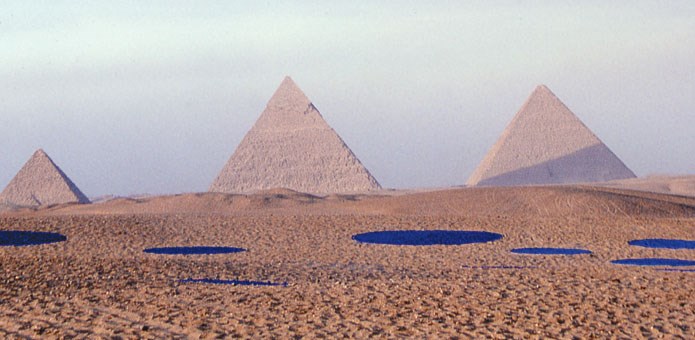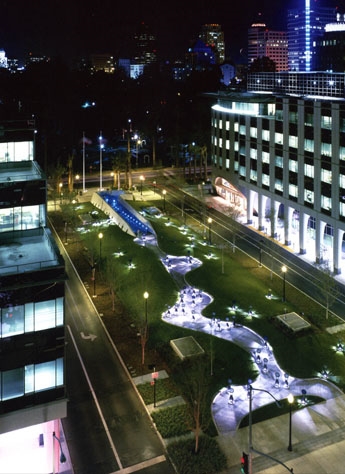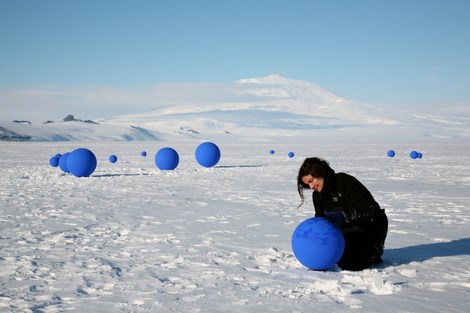Lita Albuquerque is an environmental artist who uses the earth as her canvas. She works on a grand scale, playing with time and space at the far reaches of the globe. From the Great Pyramids to the ice floes of Antarctica, Albuquerque uses the language of art to explain the common threads that bind humanity.
Born in Santa Monica, California, Albuquerque's childhood years were divided between the North African nation of Tunisia, Paris, France and the United States. Her early work was part of the Light and Space movement, an art period spawned in the early 1970s at the University of California at Los Angeles, where Albuquerque had been a student.
 |
| Eqypt Sol-Star ( (Lita Albuquerque Studio)) |
Light and Space artists paired perceived experiences like light, scale and volume with the latest technologies of the time to give their audiences a specific sensory experience. Their work often involved focused light and transparent or reflective material. Light and luminosity became Albuquerque's subject of choice and a theme that would permeate her career.
By the end of the 70s, Albuquerque had gained national acclaim in an art medium that she has continued to work with through the decades, landscape installations that involve pigment. In 1980, she unveiled the Washington Monument Project, a shadow calendar made by trenches carved into the ground along the sides of the Washington Monument's stone pillar. The installation earned awards and Albuquerque gained some prestigious commissions from its success.
Sol Star, her massive art project near Egypt's Great Pyramids earned Albuquerque the esteemed Cairo Biennale Prize in 1997. During the exhibition, Albuquerque used ecologically friendly blue pigment to create a map of the stars on the Giza desert plateau. Ninety-nine large blue circles represented the stars in the sky above. The high desert winds destroyed the artwork within days but not before Albuquerque, representing the United States, won first prize in the prestigious competition.
 |
| Golden State ( (Lita Albuquerque Studio)) |
Sol Star was one of many public art projects by Albuquerque, who has earned commissions in many states and in several foreign countries.  Golden State, which she created in 2003 with architect Mitchell De Jarnett, was the largest commission of public art in the history of California's state government.  The project spanned 1.5 acres, two city blocks near the state capitol.  The extensive installation includes space for contemplation as well as conversation.  Two 25-ft "rain curtains" create an interesting frame for the capitol dome behind them.  A stone amphitheater surrounds a circular stage that holds an inscription that serves as a "key" to decipher the installation.
At the Cathedral of Our Lady of the Angels, in Los Angeles, sits a collaborative effort by Albuquerque and architect Robert Kramer in 2002.   A small plaza outside the cathedral holds the "Gateway Pool" and "Water Wall," both based on Biblical scripture.   The words, "I shall give you living water," are inscribed in a flat, circular marble disk.  The text is translated into the 37 languages of the worshippers who attend services at the cathedral.  As water flows from the center of the disk, the words are unveiled from beneath its rippled surface.  The pavement surrounding the fountain is the backdrop for a "Star Map," which represents the configuration of the stars above the cathedral on the night before the its dedication.
Albuquerque's artwork decorates cities, universities, libraries, embassies and private corporations around the world.  Her work can be seen at the Smithsonian Institution's Archives of American Art, the Whitney Museum of Art, the Museum of Contemporary Art in Los Angeles, The Orange County Museum, the Laguna Art Museum and the Palm Desert Museum.
A noteworthy educator, she has served on the faculty of Art Center College of Design's Fine Art Graduate Program for more than 20 years. She currently teaches classes in sculpture and theories of construction. In 2007, she was one of only five contemporary artists commissioned to work with NASA astrophysicists at the Spitzer Science Center at the California Institute of Technology. The Spitzer Center's Jet Propulsion Lab manages the infra-red deep-space Spitzer Space Telescope. The scientists shared their knowledge with the artists and allowed them access to their technological resources. The result was the 17-month long project and exhibition OBSERVE, which combined art and science.
One of Albuquerque's most extraordinary art accomplishments took place on the Ross Ice Shelf in Antarctica in 2006. The installation Stellar Axis: Antarctica was funded by a National Science Foundation grant. It consisted of 99 blue fiberglass spheres, which were set on the ice in precise alignment with the same number of stars in the sky above. The size of each blue orb was in direct proportion to the relative brightness of its corresponding star.
 |
| Lita Albuquerque - Antarctica ( (Lita Albuquerque Studio)) |
Albuquerque's most recent work, Spine of the Earth, was a recreation of her 1980 installation, which took place in a dry lakebed in California's Mojave Desert. Using the earth as background, art students from California State University at Long Beach decorated the desert floor with a 600-foot wide geometric pattern in pigments of red, black and yellow. The work could only be seen from the sky.
For her 2012 installation, more than 500 people donned red jumpsuits and walked along a fissure in the earth outside of Los Angeles at the Baldwin Hills Scenic Overlook in Culver City. The work symbolized an ethereal line that links the earth's core with the heavens.
Whether on a public landscape or in a private museum, Albuquerque uses color and light to tie together the concepts of time, space and humanity. While some of her work is permanent, much of it is fleeting, ephemeral, like the human connection with the earth itself.
Page created on 2/9/2012 12:22:33 PM
Last edited 1/4/2017 9:49:36 PM
